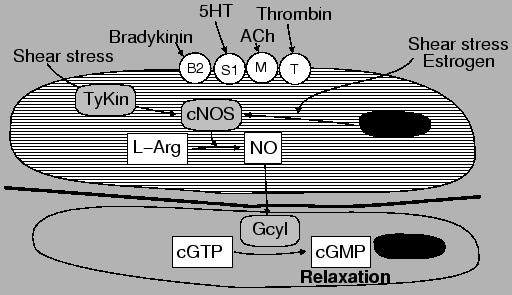



Next: Nitric Oxide
Up: Outline of endothelial function
Previous: Endothelial permeability
Index
Endothelial cells produce vasodilating and vasoconstricting substances that
effect vascular smooth muscle. The main vasodilating substance produced,
endothelial derived relaxing factor was detected in 1980 and identified as
nitric oxide (NO) in 1987. Another vasodilator produced by endothelial cells
is prostacyclin (Prostaglandin I2, PG-I2). The main vasocontrictors are endothelin-1,
thromboxane-A2, superoxide anion and prostaglandin H2 (PG-H2), see
figure 1.
There are receptors on the endothelial cell for acetylcholine, bradykinin,
serotonin, thrombin and substance P. Activation of these receptors results in
production and release of NO.
One of the characteristics of endothlial dysfunction is impairment or loss of
endothleium-dependent vasodilatation. This is due to an imbalance between
vasodilators and vasocontrictors with respect to production and release.
Figure 9:
Schematic
representation of endothelial derived smooth muscle relaxation. The
endothelial cell is at the top of the diagram, the smooth muscle cell at the
bottom and the basmement membrane inbetween. Various neurotransmitters,
thrombin and substance P stimulate nitric oxide synthetase (cNOS). cNOS
converts L-arginine to nitric oxide (NO). NO is released luminally and
abluminally. On the abluminal side NO activates guanyl cyclase to increase the
amount of cGMP in the smooth muscle cell. This results in relaxation. cNOS is
constitutively expressed, expression may be enhanced by shear stress and
estrogen. The activity of cNOS may be increased rapidly without increased
expression by shear stress which probably activates a tyrosine kinase.
 |
Subsections




Next: Nitric Oxide
Up: Outline of endothelial function
Previous: Endothelial permeability
Index
Adrian P. Ireland